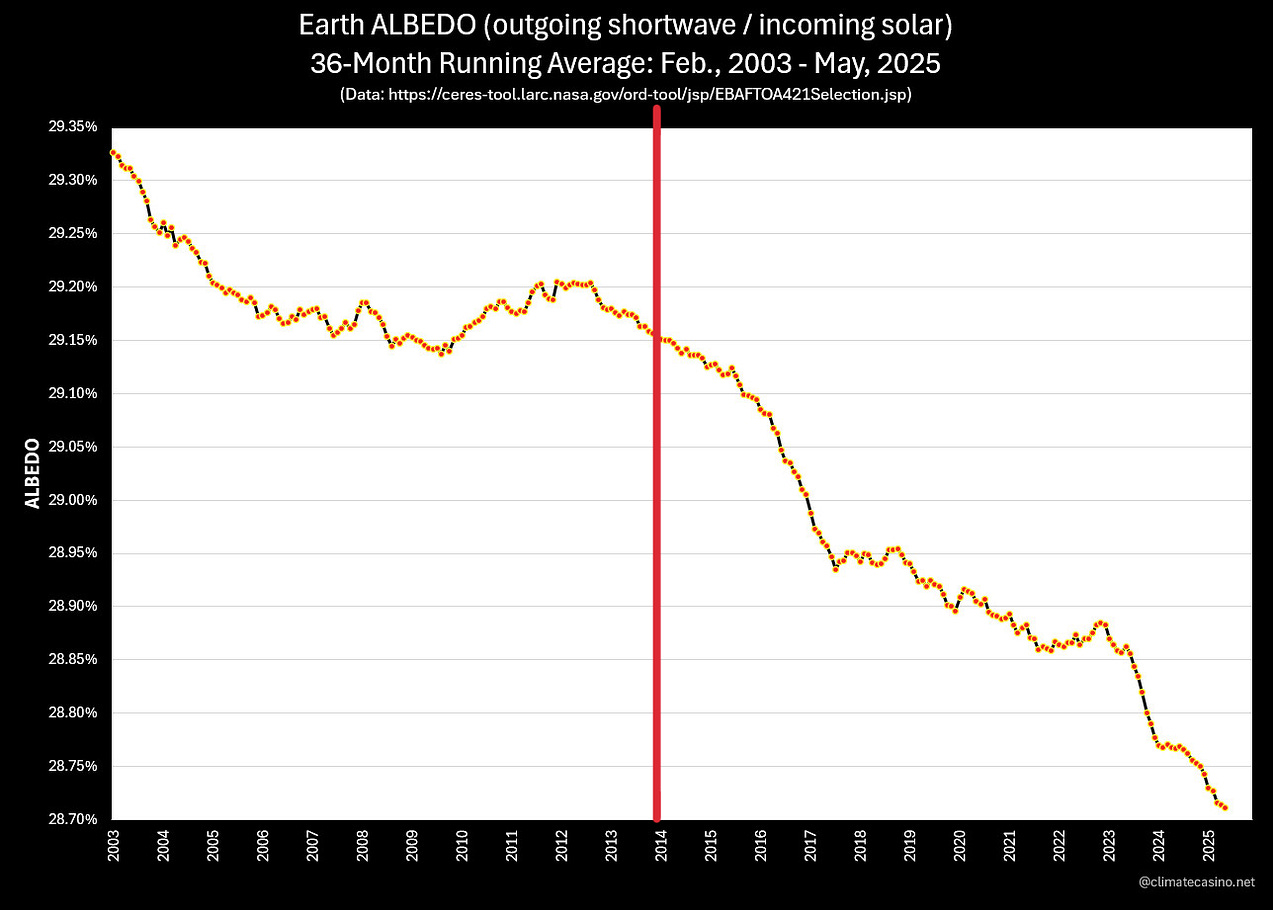
Albedo “dimming” has INTENSIFIED since 2014. This dimming has now persisted for over TEN YEARS and has quadrupled the annual ENERGY flow into the Climate System since 2000.
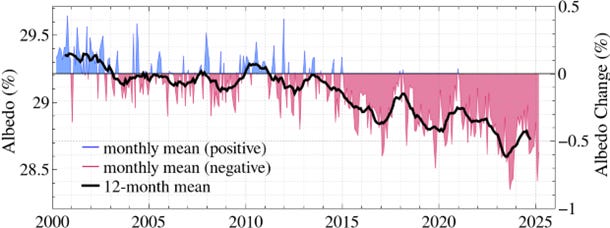
Solar radiation reaching Earth is about 340W/m2, averaged over Earth’s surface, so the -0.5% albedo decrease is a +1.7W/m2 increase of absorbed solar energy.
A +1.7 W/m2 increase of absorbed solar energy is huge. If it were a climate forcing, it would be equivalent to a CO2 increase of +138 ppm. — James Hansen
THAT’S LIKE ADDING +138ppm OF CO2e to the atmosphere SINCE 2014.
+138ppmCO2e in JUST 11 YEARS.
This has had a BIG effect on the Earth Energy Imbalance or EEI.
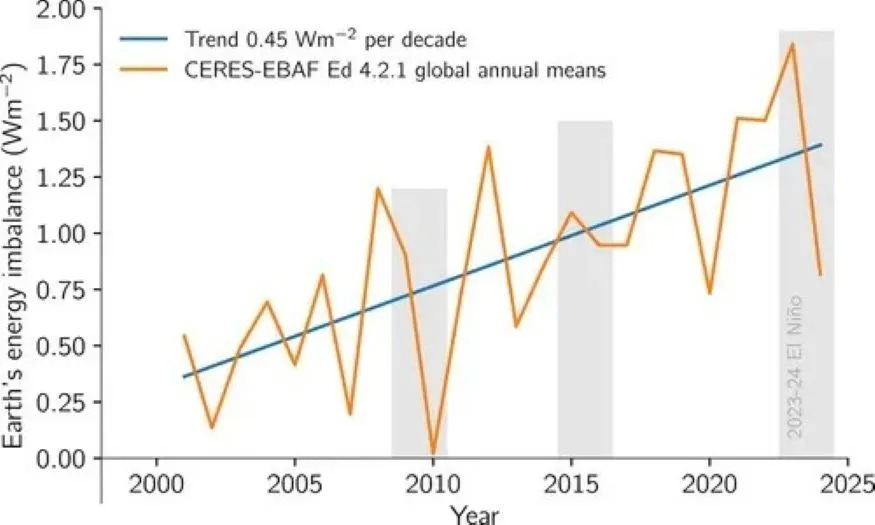
Because of Albedo Diminishment the amount of ENERGY going into the Climate System has increased from around +0.4W/m2 in 2004 to around +1.6W/m2 (averaging Hansen and Berkeley Earth’s estimates) in 2024. That +1.6W/m2 is a global average, 80% of the ENERGY in the Climate System starts in the Tropics. 90% of that ENERGY goes into the Oceans.
Which is WHY, the oceans are not “cooling down” after the MASSIVE El Nino we just had in 23/24.
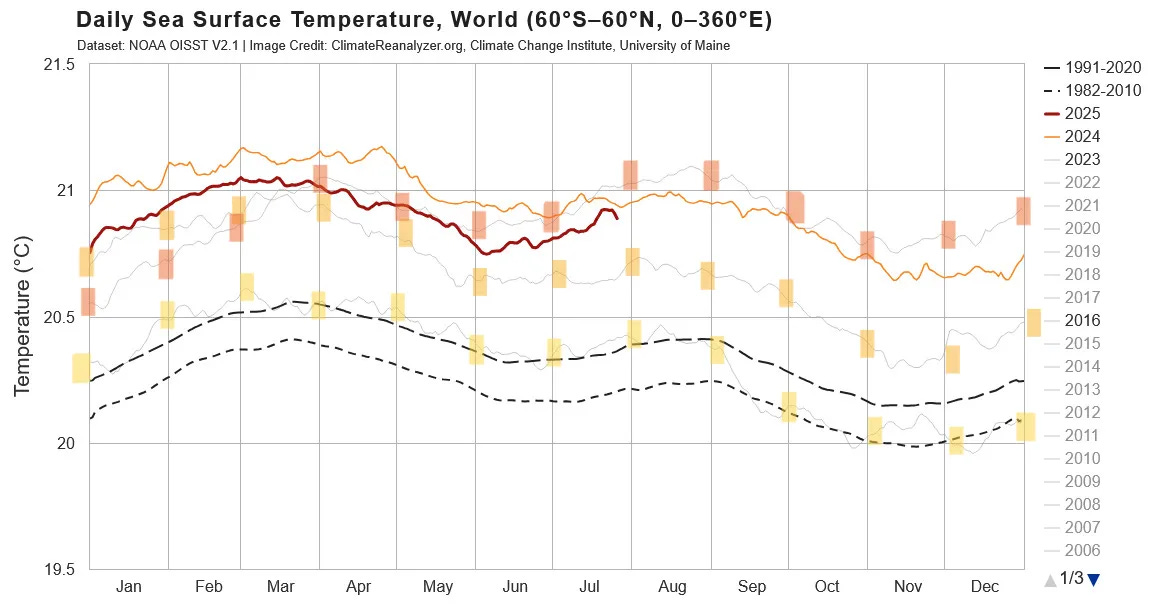
Sea Surface Temperatures are roughly 19 days away from their mid-year peak. 2024 didn't break 21°C in August, but 2023 did. If 2025 peaks above 2024 it could be the second hottest year on record.
In a typical year between 1979 and 2000, the average temperature in the northern hemisphere temperature would break the 21C (70F) barrier in July and continue for about five weeks, according to University of Maine’s Climate Change Institute.
Last year, the hottest on record, the northern hemisphere’s average temperature held above 21°C from June 13th until September 5th.
At a MINIMUM 2025 will be the 3rd hottest year on record. Right behind 2023 and 2024.
Remember, 90% of ENERGY from the Sun goes into the oceans.
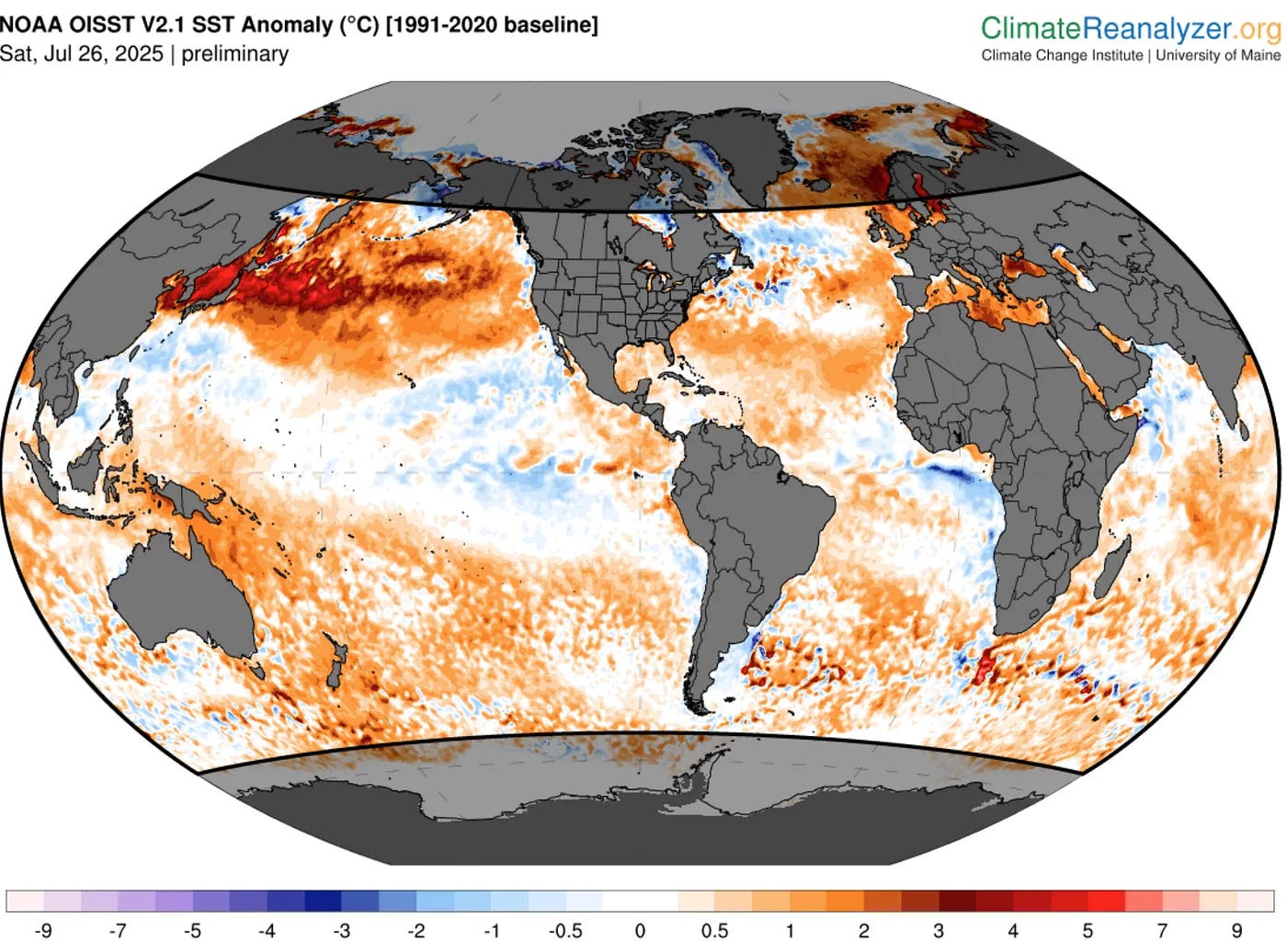
And 80% of that ENERGY enters the Climate System in the Tropics, between the Tropic of Cancer and the Tropic of Capricorn.
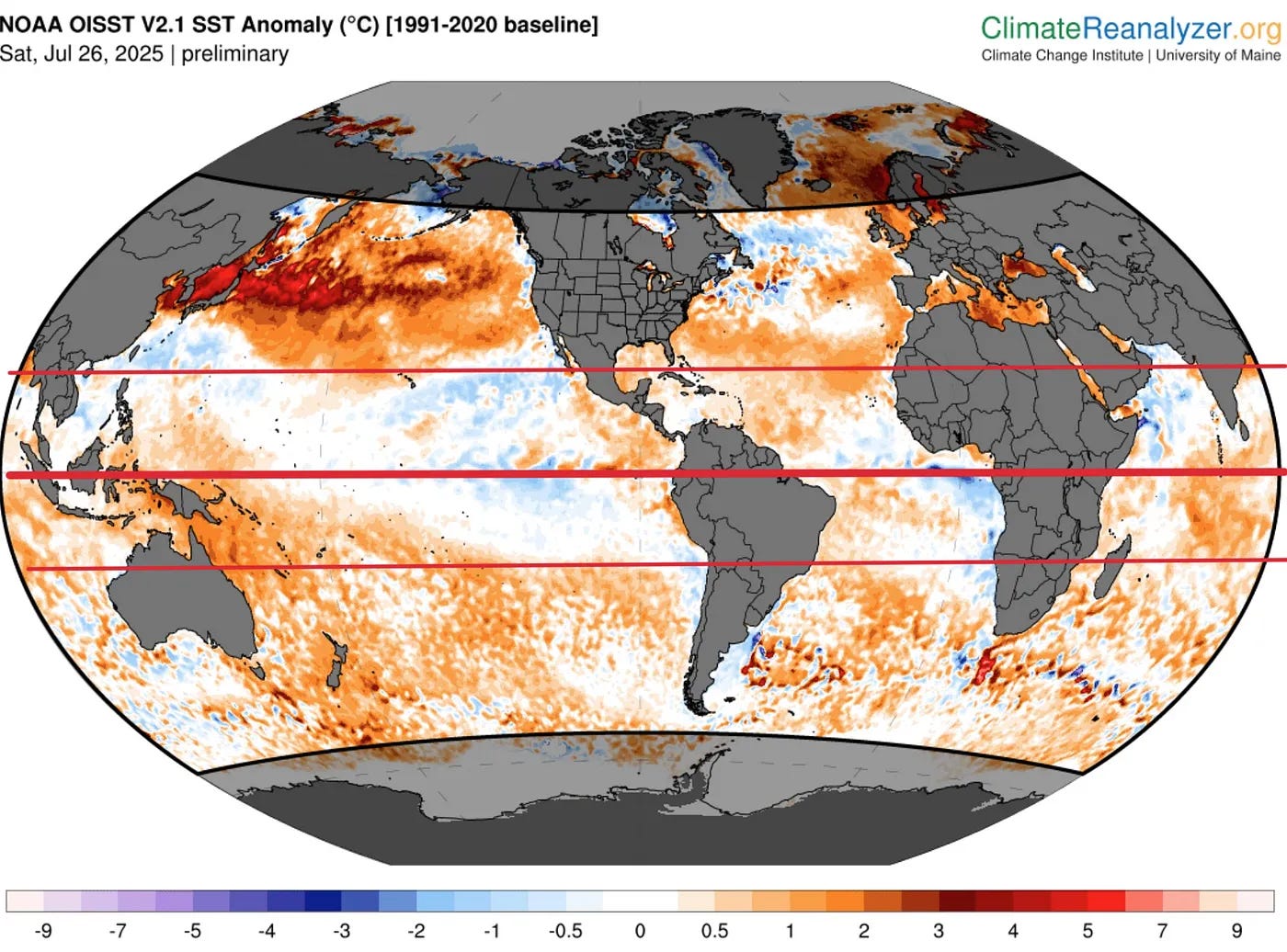
Put these observations together and what does it tell you?
WARMING IN 2025 IS BEING SUPPRESSED BY LA NINA CONDITIONS.
That’s what those “cooler than average” waters in the tropics mean. Those waters are cold upwellings from the deep ocean. They come to the surface and start absorbing ENERGY from the Sun. Literally cooling the planet down like water in a radiator absorbing HEAT.
Water that’s “cooler than average” in the Tropics, is water that’s ABSORBING HEAT like a sponge.
Meanwhile the HEAT from the 23/24 El Nino has now fully moved into the mid-latitudes. Which are sweltering.
Week of sweltering US heat - is this the new normal in a warming world?
Experts say brutal temperatures across much of US set to become more common as planet continues to heat up…..www.theguardian.com
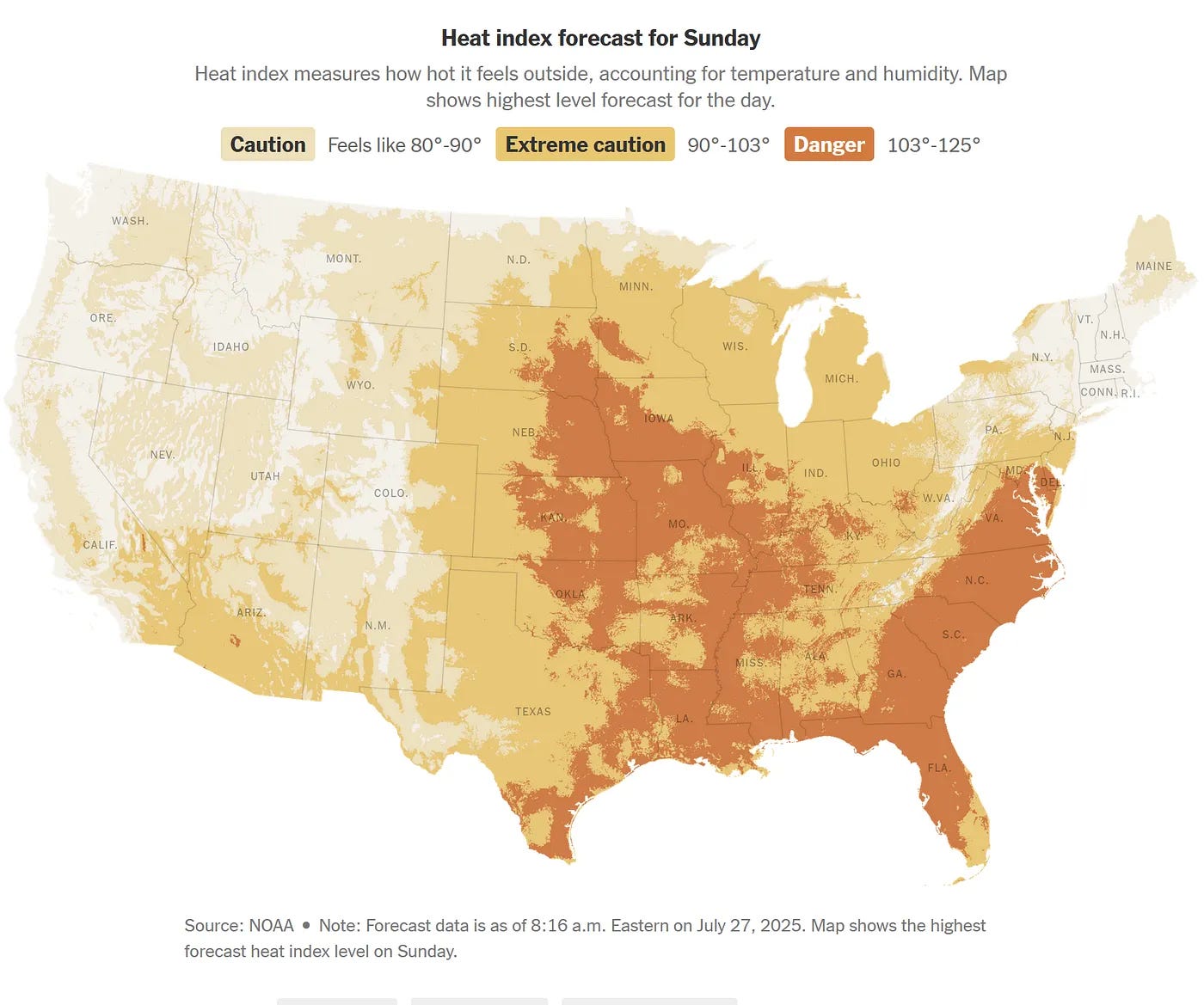
About 92.7 million people — 28 percent of the population of the contiguous United States — live in the areas expected to have dangerous levels of heat.
Think about what the body count would be WITHOUT air conditioning.
This isn't a “one off” event that may never happen again for the rest of your life. Some fluke of natural variation that happens once every 100 years.
These kinds of heatwaves are going to get WORSE from here on out. This NEVER goes back to “what it was before”. That's what “new normal” means.
There is no going back.
Iranians asked to limit water use as temperatures hit 50C and reservoirs are depleted
Public holiday announced in Tehran as government tries to grapple with deepening water crisis…..www.theguardian.com
FYI — 50°C is 122°F.
Copernicus: Third-warmest June globally - Heatwaves in Europe amid temperature extremes across both……..The Copernicus Climate Change Service (C3S), implemented by the European Centre for Medium-Range Weather Forecasts on…
Extraordinary March heatwave in Central Asia up to 10 °C hotter in a warming climate…..In March 2025, Central Asia experienced an unusually intense heatwave, with temperatures reaching record highs across - www.worldweatherattribution.org
Rising temperatures and extreme weather hit Asia hard…..The WMO's State of the Climate in Asia 2024 report says that 2024 was the warmest or second warmest year on record - wmo.int
Asia is currently warming nearly twice as fast as the global average, fuelling more extreme weather and wreaking a heavy toll on the region’s economies, ecosystems and societies, — WMO
The 2025 Heatwave in Southeast Asia: A Window Into the Future
While heatwaves intensify, demographic, economic and urbanisation factors worsen their negative impacts in Southeast…www.climateimpactstracker.com
Scientists consider South Asia a window into the future of extreme heat. Recent studies revealed that events like the April 2025 heatwave were 4°C higher over the past 30 years than the average between 1950 and 1986.
Disturbingly, academics found that the weather extremes took place during a neutral phase and not El Niño, which usually further boosts temperature rise.
THE REST OF YOUR LIFE THINGS ARE GOING TO GET HOTTER.
Warming is being “suppressed” this year. It could be HOTTER.
Next year I think it will be. Next year I think we are going to have another BIG El Nino.
Because this reminds me a lot of what 2022 was like.
The Crisis Report — 02 - May 2022
The UN has confirmed that we are about to get a massive temperature spike….medium.com
Now, the only question is, “how hot is it going to get”?
In 2022 I asked that question.
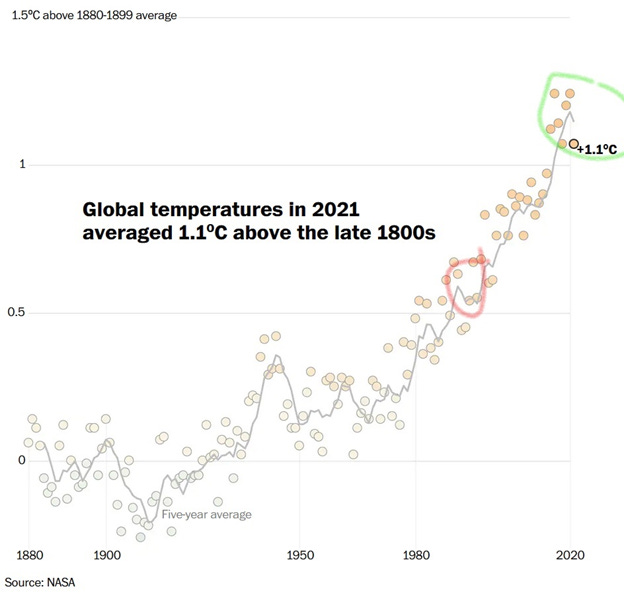
2021 was the seventh year in a row in which global temperatures were more than +1°C above the preindustrial average.
Short of geoengineering the climate, no one alive today will EVER see the world’s temperature drop below that +1°C benchmark again. 2014 represents a “Lost World” that we can never go back to.
The WMO forecast that the next five years (2022–2026) would be the “hottest on record”. They also stated that during this period the GMST could “temporarily” exceed +1.5°C of warming over baseline.
World has 50–50 chance of hitting 1.5C mark soon: U.N. — Frontline India
Forecasters also say there’s a 93 per cent chance that the five years from 2022 to 2026 will be the hottest on record.
My conclusions that May were:
The IPCC is forecasting a warming peak of +0.4°C during the next El Nino.
James Hansen is forecasting a warming peak of +0.6°C during the next El Nino.
I am forecasting a warming peak of +0.8°C during the next El Nino.
We are all saying there is going to be warming. We are all saying part of that warming is going to be an El Nino (that’s what the IPCC is implying when they say the warming will be temporary). We are all saying that some of this warming is going to be caused by SOx getting washed out of the atmosphere.
We are all saying the same thing, we just disagree about how hot it’s going to get. — May 2022.
— — — — — — —
Well, we all know how that turned out. Temperatures PEAKED at just over +2°C for several days in 2023.
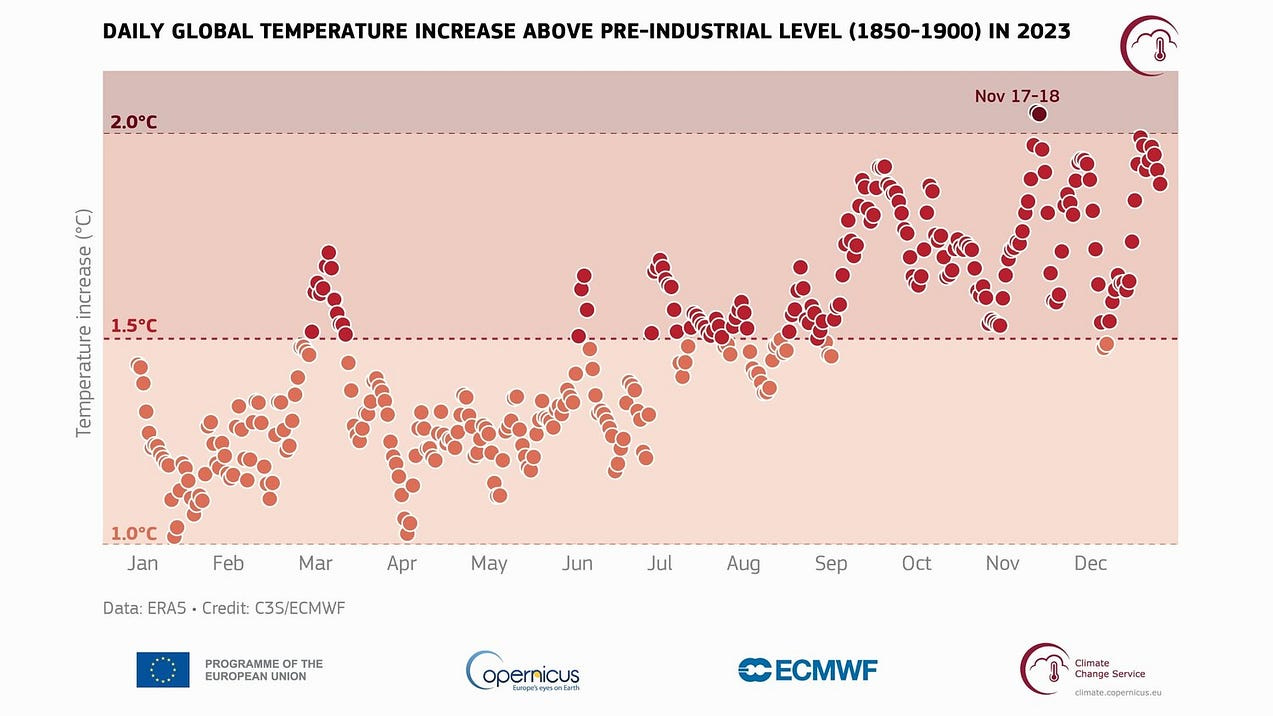
2024 AVERAGED a Global Mean Surface Temperature of +1.6°C of warming over baseline.
2025 has barely “cooled off” at all. DESPITE being a La Nina year. The La Nina pattern is barely suppressing global temperatures from climbing higher.
Here's what the WMO forecast this May, 2025.
WMO Global Annual to Decadal Climate Update (2025-2029)
The Global Annual to Decadal Climate Update is issued annually by the World Meteorological Organization (WMO). It…wmo.int
The report forecasts that the annually averaged global mean near-surface temperature for each year between 2025 and 2029 is predicted to be between +1.2°C and +1.9°C higher than the average over the years 1850–1900.
Did you catch that?
The WMO is saying that we WILL have an El Nino during this period with sustained temperatures of “up to” +1.9°C for as long as a year.
Sometime during the next five years.
Remember, in 2022 they forecast that temperatures would peak at around +1.5°C and then cool down back to between +1.2°C and +1.3°C. They didn't think there was going to be an El Nino in 2023.
As late as January 2023 the mainstream forecasts stated there was only a 50/50 shot of an El Nino developing in 2023.
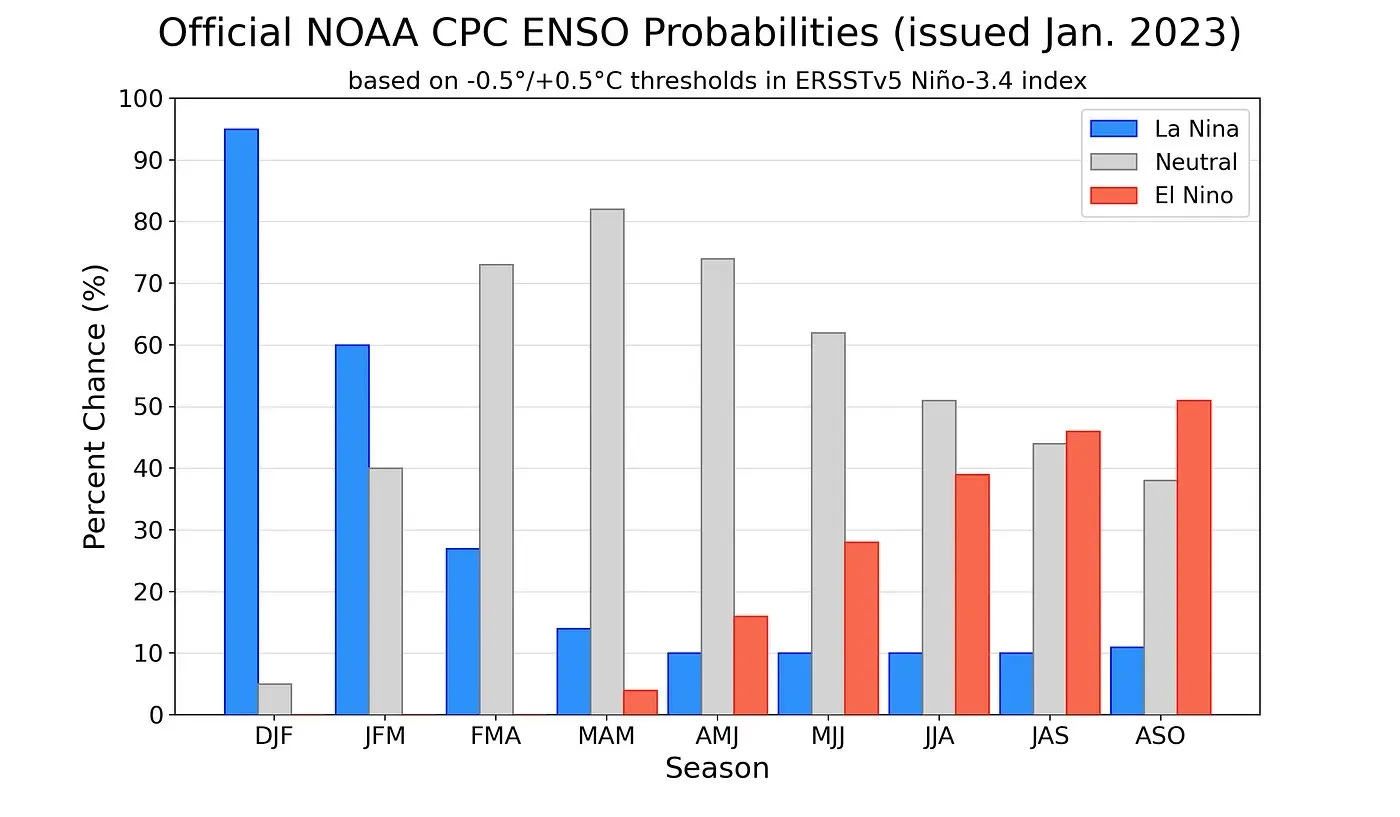
NOAA is confident that we will not get an El Nino this Fall/Winter.
The Mainstream looks at global surface temperatures slightly cooling down from 2024’s highs.
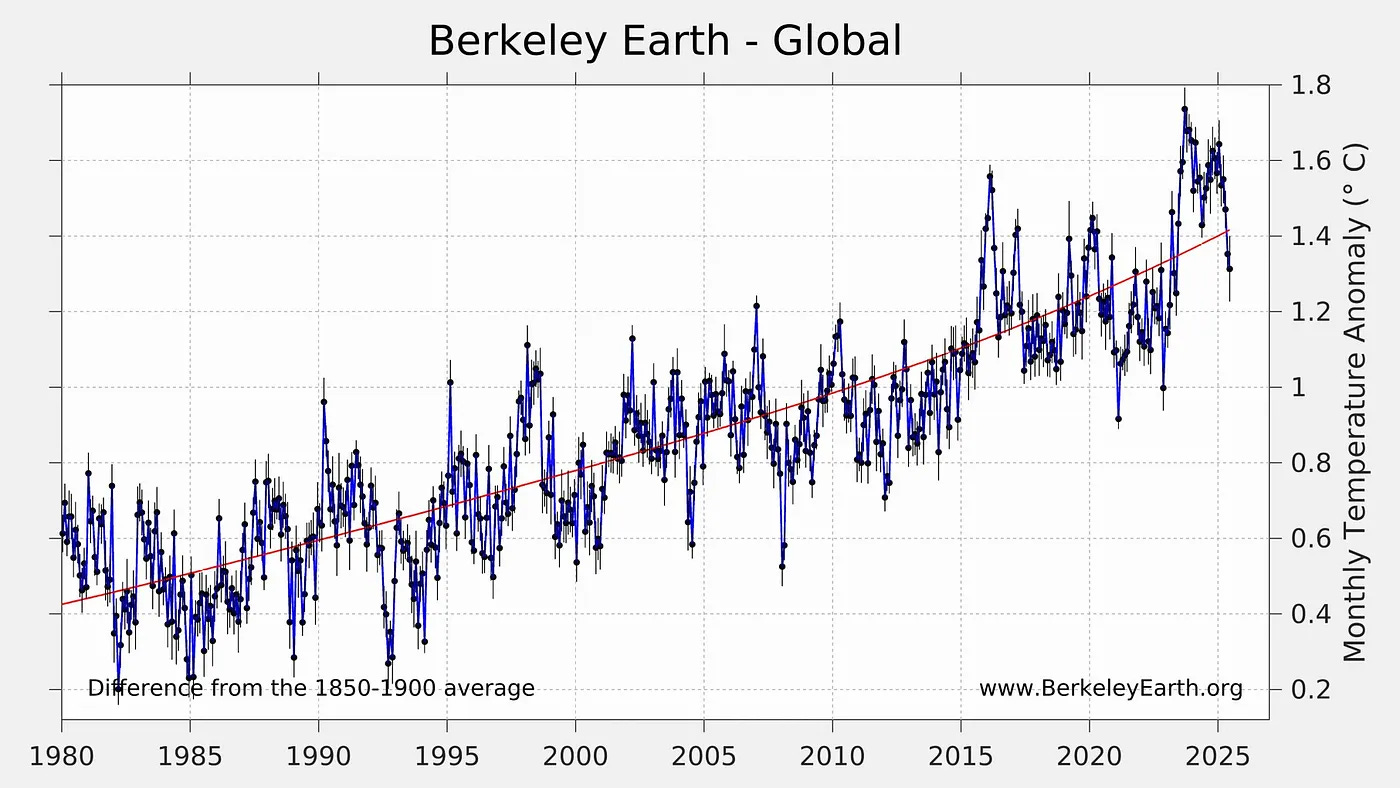
And, IMMEDIATELY picks up the narrative that the crisis is over, “it appears that 2025 may be tracking a more typical path, more consistent with the gradually rising temperatures in prior years”.
AS IF THIS MEANS NOTHING.
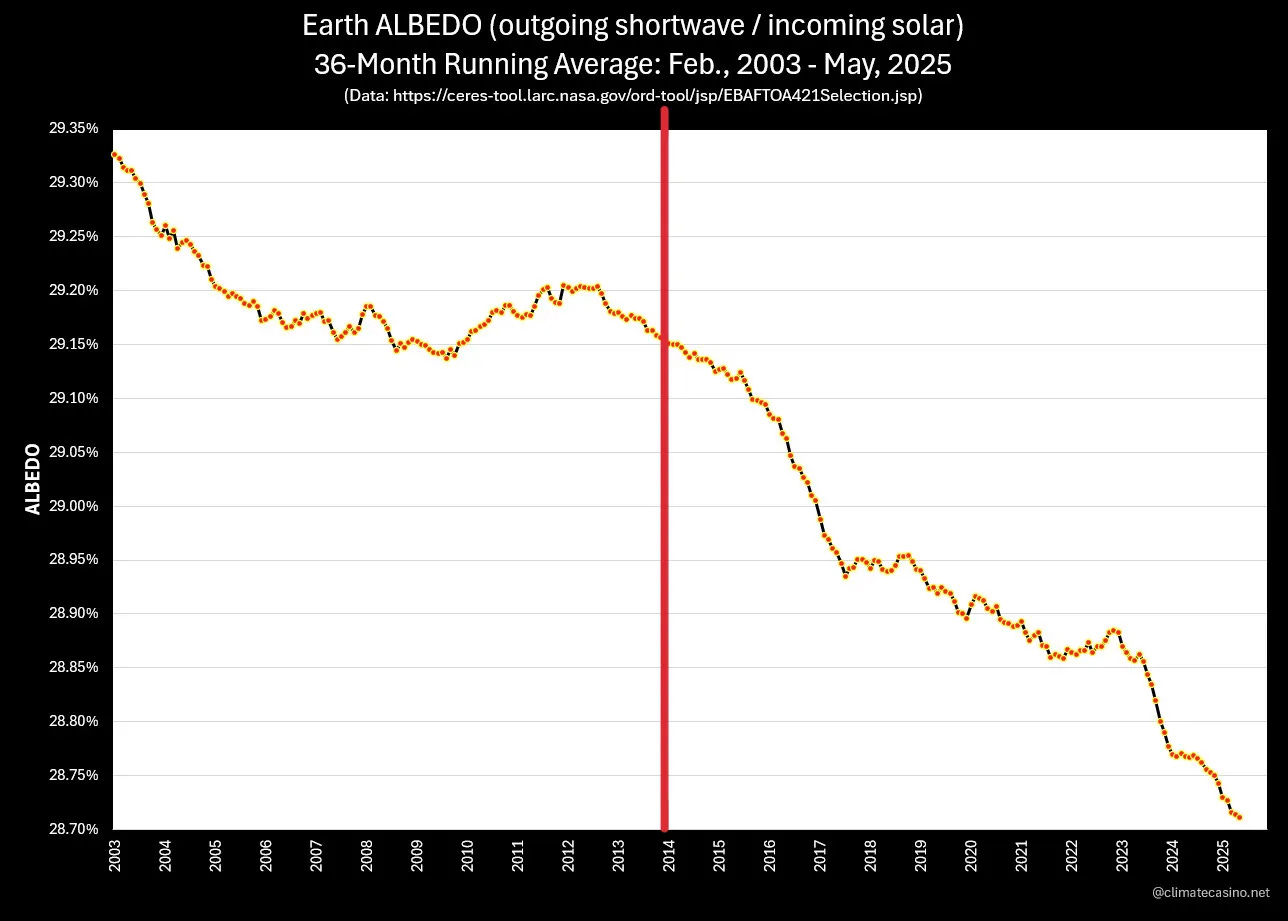
I am going to forecast that we will get another El Nino in 2026. 26/27 is going to be much like 23/24 except HOTTER.
Because the oceans are RAPIDLY soaking up HEAT this year.
In 2022, a La Nina pattern suppressed overall warming. Despite that global temperatures increased by +0.1°C DURING a La Nina Year.
This year, a La Nina pattern is suppressing warming going above +1.6°C over baseline.
In 26/27 I think temperatures will go over +2°C for MONTHS during a MASSIVE El Nino.
The global food situation is going to get MUCH, MUCH WORSE in 2026.
This is my analysis.
This is what I see.
This is my “Crisis Report”.
rc 07/28/2025
ADDENDUM:




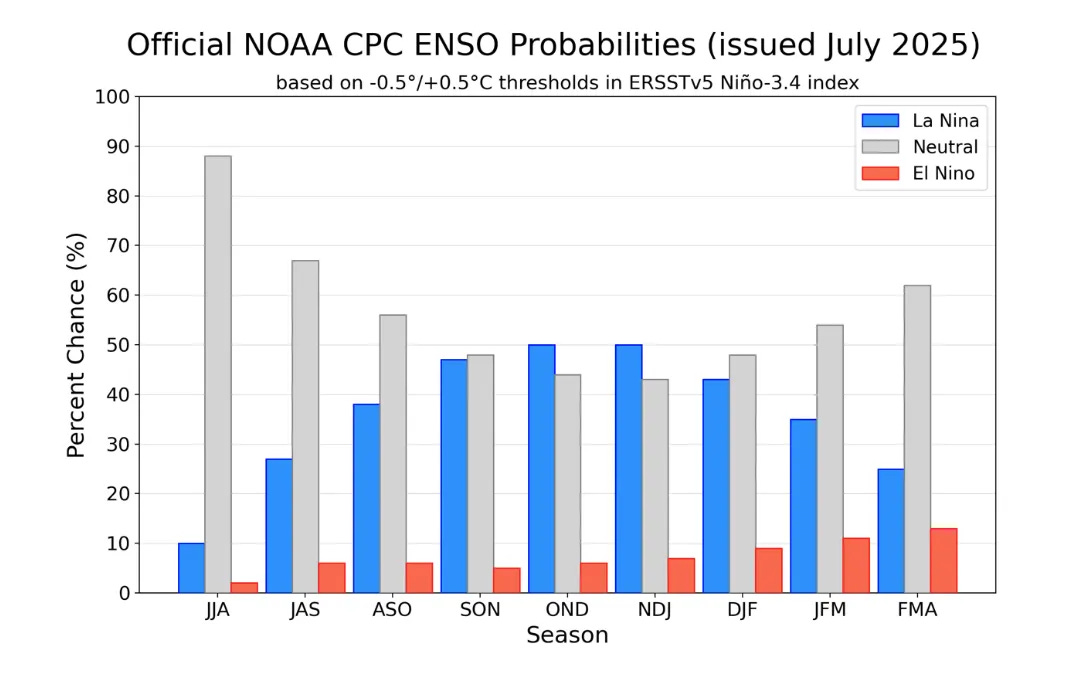
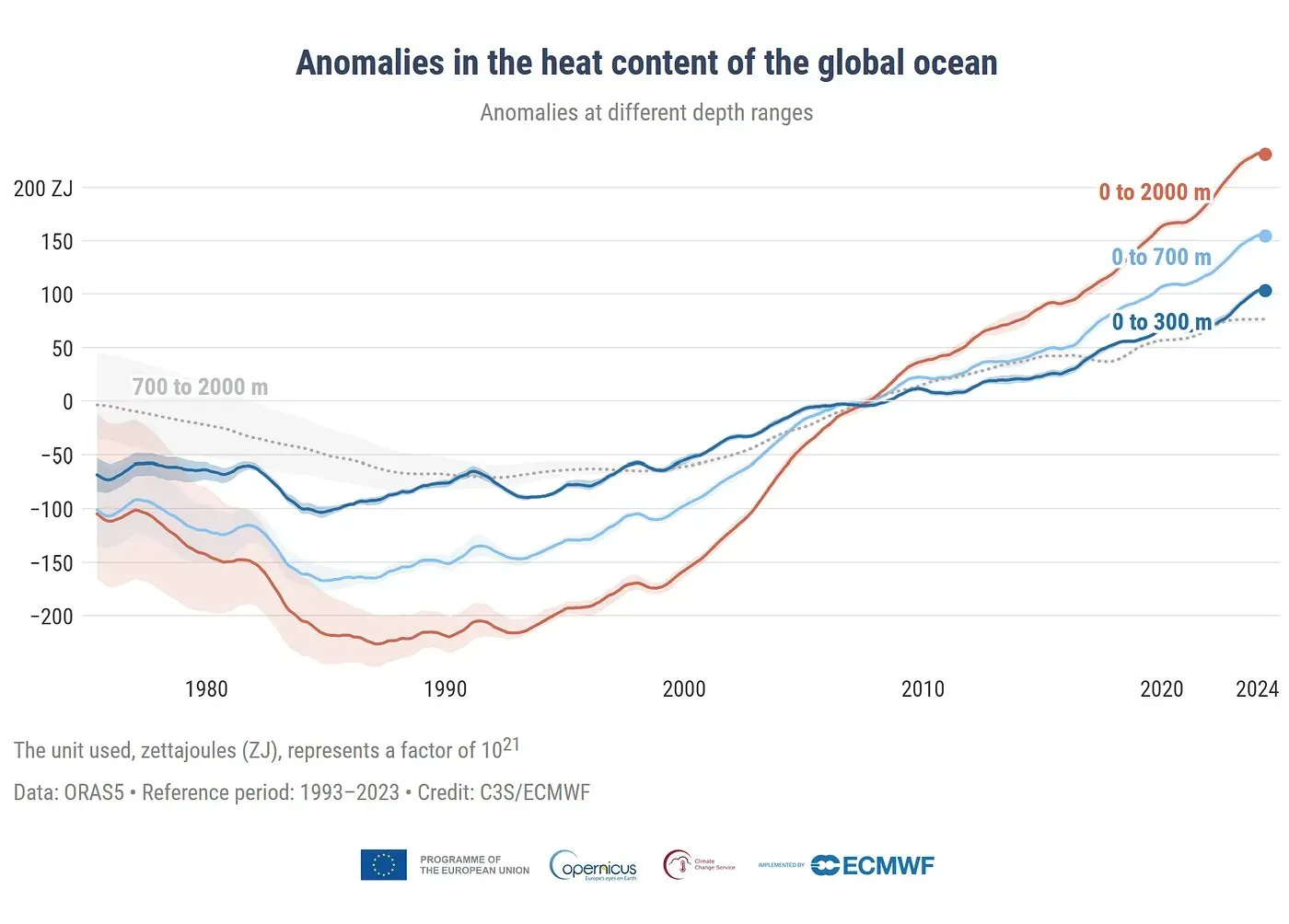
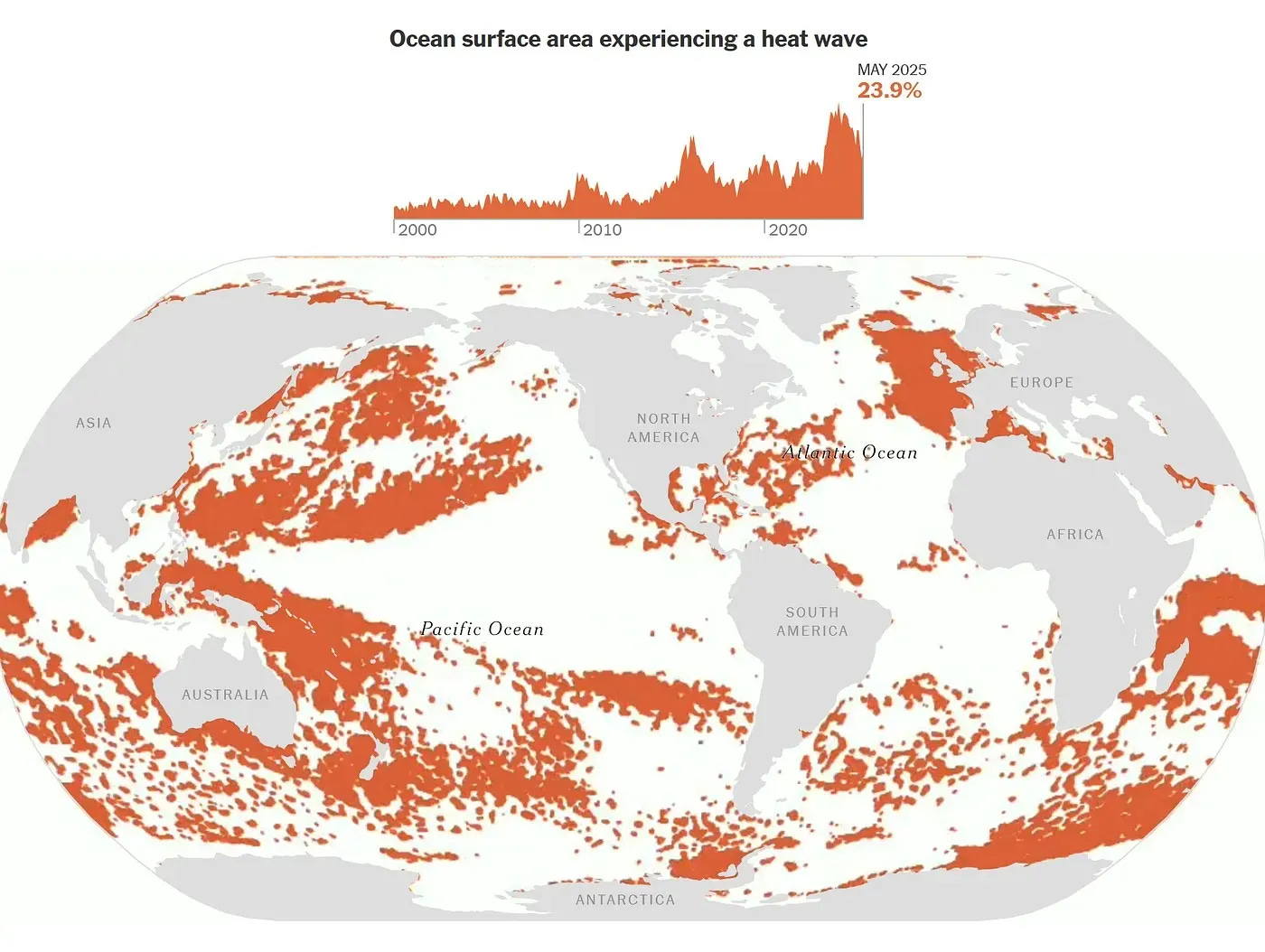
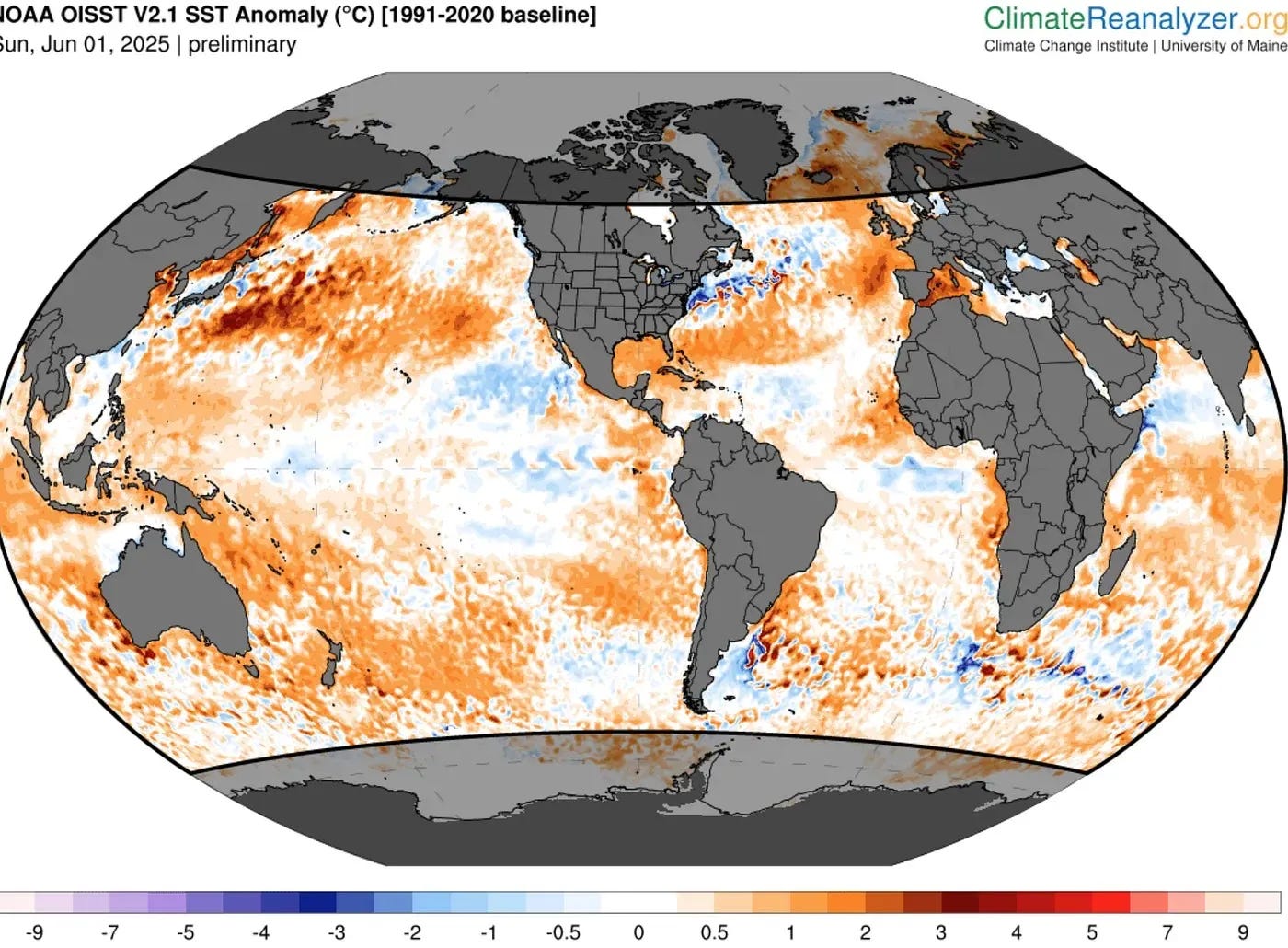

Excellent analysis Richard. Everyone though is applying "conservative" analysis. No one wants to believe how bad things really are, and how fast they are getting worse. Collectively we are as a result living in denial.
This level of heating is killing the oceans. Gas laws will cause loss of oxygen as the temperatures rise. Great vortices of anoxic water will form killing everything in large areas of the oceans allowing for a shift to purple cyanobacter.
Under those conditions iron "rains" out of the ocean further depriving life of essential nutrients. H2S is emitted instead of oxygen. Slowly at first the oxygen levels of the air decline as the oceans and forests reduce oxygen production. Over a long period during the crash, this transiently reduces the atmospheric O2 levels.
If the past is prelude, it may drop to 14% during the transition, as pressure doubles. Large animals simply lie down, pass out and die from low O2, heat stress, and evapotranspiration stresses. Whole orders go extinct in a geologic blink.
Humans included - mostly. A spare few with extreme high altitude genes survive.
But that is the far future. In the near future, in our lifetimes, rising heat drives wetbulb temperatures into the lethal zone for large areas of the Earth. Parts of Pakistan, Iran, India and the desert Southwest of the US get there first. The south and southeast parts of the US soon follow due to high humidities.
By midcentury half of Texas is unsurvivable without AC. But heat stress overwhelms power production rendering AC liable to loss.
Mass population migrations away from the highest heat zones drive wars. Drought, deluge, pestilence, disease and ecosystem shifts drive all sorts of problems.
It is all going to be so exciting. And not in a good way.
The "Anomalies in the heat content of the global ocean" graph worries me.
If I'm interpreting that correctly, since 2008 the 0-2000m heat content anomaly has been rising faster than the shallower 0-300m or 0-700m ranges.
Given that below about 1000m you're BELOW the thermocline and into the deep/abyssal ocean where the temperature is normally fairly stable at 4C, this implies that the warming has pushed down through that layer and into the deep ocean.
Which in turn has big implications for water mixing, ocean currents, sea life food chains etc.
That would seem to be bad... very, very, bad...